Updating Standards of Facial Growth in Romanian Children and Adolescents Using the Anthropometric Method—A Pilot Study
Abstract
1. Introduction
2. Materials and Methods
2.1. Instruments Used for the Simplified Orthodontic Technique in Orthodontics, Pedodontics and Growth Studies
2.2. Selection and Marking of the Main Reference Points
2.3. The Workiflow on Children of Different Ages
2.4. Sample Description, Study Protocol and Data Analysis
3. Results
4. Discussion
4.1. Study Limitations
4.2. Future Perspectives
5. Conclusions
Author Contributions
Funding
Institutional Review Board Statement
Informed Consent Statement
Data Availability Statement
Acknowledgments
Conflicts of Interest
References
- Proffit, W.R.; Fields, H.W.; Sarver, D.M. Contemporary Orthodontics, 4th ed.; Mosby Elsevier: St. Louis, MO, USA, 2007; pp. 26–71, 167–233. [Google Scholar]
- Enlow, D.H.; Hans, M.G. Essentials of Facial Growth; W.B. Saunders Company: Philadelphia, PA, USA, 1996; pp. 1, 5, 15, 122, 123, 133–145. [Google Scholar]
- Bishara, S.E. Textbook of Orthodontics; W.B. Saunders Company: Philadelphia, PA, USA, 2001; pp. 31–80, 134–142. [Google Scholar]
- Graber, T.M. Orthodontics: Principles and Practice, 3rd ed.; W.B. Saunders Company: Philadelphia, PA, USA, 1972. [Google Scholar]
- Honn, M.; Goz, G. Reference Values for Craniofacial Structures in Children 4 to 6 Years Old: Review of the Literature. J. Orofac. Orthop. 2007, 68, 170–182. [Google Scholar] [CrossRef] [PubMed]
- Yasas, S.N.; Jayaratne, R.; Zwahlen, A. Application of Digital Anthropometry for Craniofacial Assessment. Craniomaxillofac. Trauma Reconstr. 2014, 7, 101–107. [Google Scholar] [CrossRef]
- Salter, E.M.; Kolar, J.C. Anthropometry. In Encyclopedia of Measurement and Statistics; Salkind, N.J., Ed.; Sage Publications: Thousand Oaks, CA, USA, 2007; Volume 1, pp. 35–38. [Google Scholar]
- Kenneth, L.J. Smith’s Recognizable Patterns of Human Malformation, 6th ed.; Elsevier Health Sciences: Philadelphia, PA, USA, 2005. [Google Scholar]
- Bishara, S.E.; Jorgensen, G.J.; Jakobsen, J.R. Changes in facial dimensions assessed from lateral and frontal photographs. Part I—Methodology. Am. J. Orthod. Dentofac. Orthop. 1995, 108, 389–393. [Google Scholar] [CrossRef]
- Jodeh, D.S.; Rottgers, S.A. High-Fidelity Anthropometric Facial Measurements can be obtained from a Single Stereophotograph from the Vectra H1 3-Dimensional Camera. Cleft Palate Craniofac. J. 2019, 56, 1164–1170. [Google Scholar] [CrossRef]
- Honn, M.; Goz, G. The ideal of Facial Beauty: A Review. J. Orofac. Orthop. 2007, 68, 6–16. [Google Scholar] [CrossRef] [PubMed]
- Liu, H.; Li, Z.; Zheng, L. Rapid preliminary helmet shell design based on three-dimensional anthropometric head data. J. Eng. Des. 2008, 19, 45–54. [Google Scholar] [CrossRef]
- Rushil, R.D.; Calabrese, C.E.; Burashed, H.M.; Doyle, M.; Vernacchio, L.; Resnick, C.M. Craniofacial Anthropometry: Normative Data for Caucasian Infants. J. Craniofac. Surg. 2019, 30, e539–e542. [Google Scholar] [CrossRef]
- Kelly, K.M.; Littlefield, T.R.; Pomatto, J.K.; Ripley, C.E.; Beals, S.P.; Joganic, E.F. Importance of early recognition and treatment of deformational plagiocephaly with orthotic cranioplasty. Cleft Palate Craniofac. J. 1999, 36, 127–130. [Google Scholar] [CrossRef]
- Asha, K.R.; Lakshmiprabha, S.; Nanjaiah, C.M.; Prashanth, S.N. Craniofacial Anthropometric Analysis in Down Syndrome. Indian J. Pediatr. 2011, 78, 1091–1095. [Google Scholar] [CrossRef]
- Wilbrand, J.F.; Wilbrand, M.; Pons-Kuehnemann, J.; Blecher, J.C.; Christophis, P.; Howaldt, H.P.; Schaaf, H. Value and reliability of anthropometric measurements of cranial deformity in early childhood. J. Craniomaxillofac. Surg. 2011, 39, 24–29. [Google Scholar] [CrossRef]
- De Faria, M.E.J.; Carvalho, L.R.; Rossetto, S.M.; Amaral, T.S.; Berger, K.; Arnhold, I.J.; Mendonca, B.B. Analysis of craniofacial and extremity growth in patients with growth hormone deficiency during growth hormone therapy. Horm. Res. 2009, 71, 173–177. [Google Scholar] [CrossRef]
- Farkas, L.G.; Katic, M.J.; Forrest, C.R.; Alt, K.W.; Bagic, I.; Baltadjiev, G.; Cunha, E.; Cvicelová, M.; Davies, S.; Erasmus, I.; et al. International anthropometric study of facial morphology in various ethnic groups/races. J. Craniofac. Surg 2005, 16, 615–646. [Google Scholar] [CrossRef] [PubMed]
- Farkas, L.G.; Katic, M.J.; Forrest, C.R. Comparison of craniofacial measurements of young adult African–American and North American white males and females. Ann. Plast. Surg. 2007, 59, 692–698. [Google Scholar] [CrossRef]
- Arboledo, C.; Buschang, P.H.; Camacho, J.A.; Botero, P.; Roldan, S. A mixed longitudinal anthropometric study of craniofacial growth of Colombian mestizos 6–17 years of age. Eur. J. Orthod. 2011, 33, 441–449. [Google Scholar] [CrossRef] [PubMed]
- Milicescu, V.; Milicescu, I.D. Creşterea şi Dezvoltarea Generală şi Cranio-Facială la Copii în Perioda Dentiţiei Mixte; Editura Viata Medicala Romaneasca: Bucureşti, Romania, 2001; pp. 25–27, 29–42, 46–111. [Google Scholar]
- Firu, P. Introducere la Studiul Anomaliilor Dento-Maxilare; Ed Didactică şi Pedagogică: Bucureşti, Romania, 1983; pp. 215–227, 649–689. [Google Scholar]
- Boboc, G. Aparatul Dento-Maxilar, Formare şi Dezvoltare, 2nd ed.; Medicală: Bucureşti, Romania, 2009; pp. 117–279. [Google Scholar]
- Noyan, A.; Larson, B.E.; Leon-Salazar, V.; Beiraghi, S. Accuracy and precision of a 3D anthropometric facial analysis with and without landmark labelling before image acquisition. Angle Orthod. 2011, 81, 245–252. [Google Scholar] [CrossRef]
- Baik, H.-S.; Jeon, J.-M.; Lee, H.-J. Facial soft-tissue analysis of Korean adults with normal occlusion using a 3-dimensionallaser scanner. Am. J. Orthod. Dentofac. Orthop. 2007, 131, 759–766. [Google Scholar] [CrossRef]
- Wong, J.Y.; Oh, A.K.; Ohta, E.; Hunt, A.T.; Rogers, G.F.; Mulliken, J.B.; Deutsch, C.K. Validity and Reliability of Craniofacial Anthropometric Measurement of 3D Digital Photogrammetric Images. Cleft Palate Craniofac. J. 2008, 45, 232–239. [Google Scholar] [CrossRef]
- Heike, C.L.; Cunningham, M.L.; Hing, A.V.; Stuhaug, E.; Starr, J.R. Picture perfect? Reliability of craniofacial anthropometry using three-dimensional digital stereophotogrammetry. Plast. Reconstr. Surg. 2009, 124, 1261–1272. [Google Scholar] [CrossRef] [PubMed]
- Sforza, C.; Laino, A.; D’Alessio, R.; Grandi, G.; Catti, F.; Ferrario, V.F. Three-dimensional facial morphometry of attractive adolescent boys and girls. Prog. Orthod. 2007, 8, 268–281. [Google Scholar]
- Kanavakis, G.; Halazonetis, D.; Katsaros, C.; Gkantidis, N. Facial shape affects self-perceived facial attractiveness. PLoS ONE 2021, 16, e0245557. [Google Scholar] [CrossRef]
- Othman, S.A.; Majawit, L.P.; Wan Hassan, W.N.; Wey, M.C.; Mohd Razi, R. Anthropometric Study of Three-Dimensional Facial Morphology in Malay Adults. PLoS ONE 2016, 11, e0164180. [Google Scholar] [CrossRef]
- Fourie, Z.; Damstra, J.; Gerrits, P.O.; Ren, Y. Evaluation of anthropometric accuracy and reliability using different three-dimensional scanning systems. Forensic Sci. Int. 2011, 207, 127–134. [Google Scholar] [CrossRef] [PubMed]
- Kukharev, G.A.; Kaziyeva, N. Digital Facial Anthropometry: Application and Implementation. Pattern Recognit. Image Anal. 2020, 30, 496–511. [Google Scholar] [CrossRef]
- Menéndez López-Mateos, M.L.; Carreño-Carreño, J.; Palma, J.C.; Alarcón, J.A.; Menéndez López-Mateos, C.; Menéndez-Núñez, M. Three-dimensional photographic analysis of the face in European adults from southern Spain with normal occlusion: Reference anthropometric measurements. BMC Oral Health 2019, 19, 196. [Google Scholar] [CrossRef]
- Flores, M.R.P.; Machado, C.E.P.; Gallidabino, M.D.; de Arruda, G.H.M.; da Silva, R.H.A.; de Vidal, F.B.; Melani, R.F.H. Comparative Assessment of a Novel Photo-Anthropometric Landmark-Positioning Approach for the Analysis of Facial Structures on Two-Dimensional Images. J. Forensic Sci. 2019, 64, 828–838. [Google Scholar] [CrossRef]
- Krimmel, M.; Breidt, M.; Bacher, M.; Müller-Hagedorn, S.; Dietz, K.; Bülthoff, H.; Reinert, S.; Kluba, S. Three-Dimensional Normal Facial Growth from Birth to the Age of 7 Years. Plast. Reconstr. Surg. 2015, 136, 490e–501e. [Google Scholar] [CrossRef] [PubMed]
- Machado, C.E.P.; Flores, M.R.P.; Lima, L.N.C.; Tinoco, R.L.R.; Franco, A.; Bezerra, A.C.B.; Evison, M.P.; Guimarães, M.A. A new approach for the analysis of facial growth and age estimation: Iris ratio. PLoS ONE 2017, 12, e0180330. [Google Scholar] [CrossRef] [PubMed]
- Ionescu, E.; Milicescu, I.D.; Popescu, M.; Popoviciu, O.; Milicescu, V. Ortodonţie şi Ortopedie Dento-Facială. In Ghid Clinic şi Terapeutic (Pentru Studenţi şi Rezidenţi); Ed. Cerma: Bucureşti, Romania, 2001; pp. 33–38, 75–137. [Google Scholar]
- Matthew, J.K.; Zachary, D.R.; Carrie, L.H.; Michael, L.C.; Jacqueline, T.H.; Chung, H.K.; Nidey, N.L.; Moreno, L.M.; Wehby, G.L.; Marazita, M.L.; et al. Using the 3D Facial Norms Database to investigate craniofacial sexual dimorphism in healthy children, adolescents, and adults. Biol. Sex Differ. 2016, 7, 23. [Google Scholar] [CrossRef]
- Farkas, L.G.; Hreczko, T.M.; Katic, M.J.; Forrest, C.R. Proportion indices in the craniofacial regions of 284 healthy North American white children between 1 and 5 years of age. J. Craniofac. Surg. 2003, 14, 13–28. [Google Scholar] [CrossRef]
- Valean, C.; Tatar, S.; Nanulescu, M.; Leucuta, A.; Ichim, G. Prevalence of obesity and overweight among school children in Cluj-Napoca. Acta Endocrinol. 2009, 5, 213–219. [Google Scholar] [CrossRef]
- Moldovanu, F.; Nanu, M.; Ardeleanu, I.; Stativa, E.; Nanu IBacalearos, C. Overweight and obesity in Romanian children, in European context. Arch. Dis. Child. 2017, 102 (Suppl. 2), A1–A192. [Google Scholar] [CrossRef]
- Chirita-Emandi, A.; Barbu, C.G.; Cinteza, E.E.; Chesaru, B.I.; Gafencu, M.; Mocanu, V.; Pascanu, I.M.; Tatar, S.A.; Balgradean, M.; Dobre, M.; et al. Overweight and Underweight Prevalence Trends in Children from Romania—Pooled Analysis of Cross-Sectional Studies between 2006 and 2015. Obes. Facts 2016, 9, 206–220. [Google Scholar] [CrossRef]
- Negeow, W.C.; Aljunid, S.T. Craniofacial anthropometric norms of Malays. Singap. Med. J. 2009, 50, 525–528. [Google Scholar]
- Agnihotri, A.K.; Kachhwaha, S.; Googoolye, K.; Allock, A. Estimation of stature from cephalo-facial dimensions by regression analysis in Indo-Mauritian population. J. Forensic Leg. Med. 2011, 18, 167–172. [Google Scholar] [CrossRef]
- Krishan, K.; Kumar, R. Determination of stature from cephalo-facial dimensions in a North Indian population. Leg. Med. 2007, 9, 128–133. [Google Scholar] [CrossRef] [PubMed]

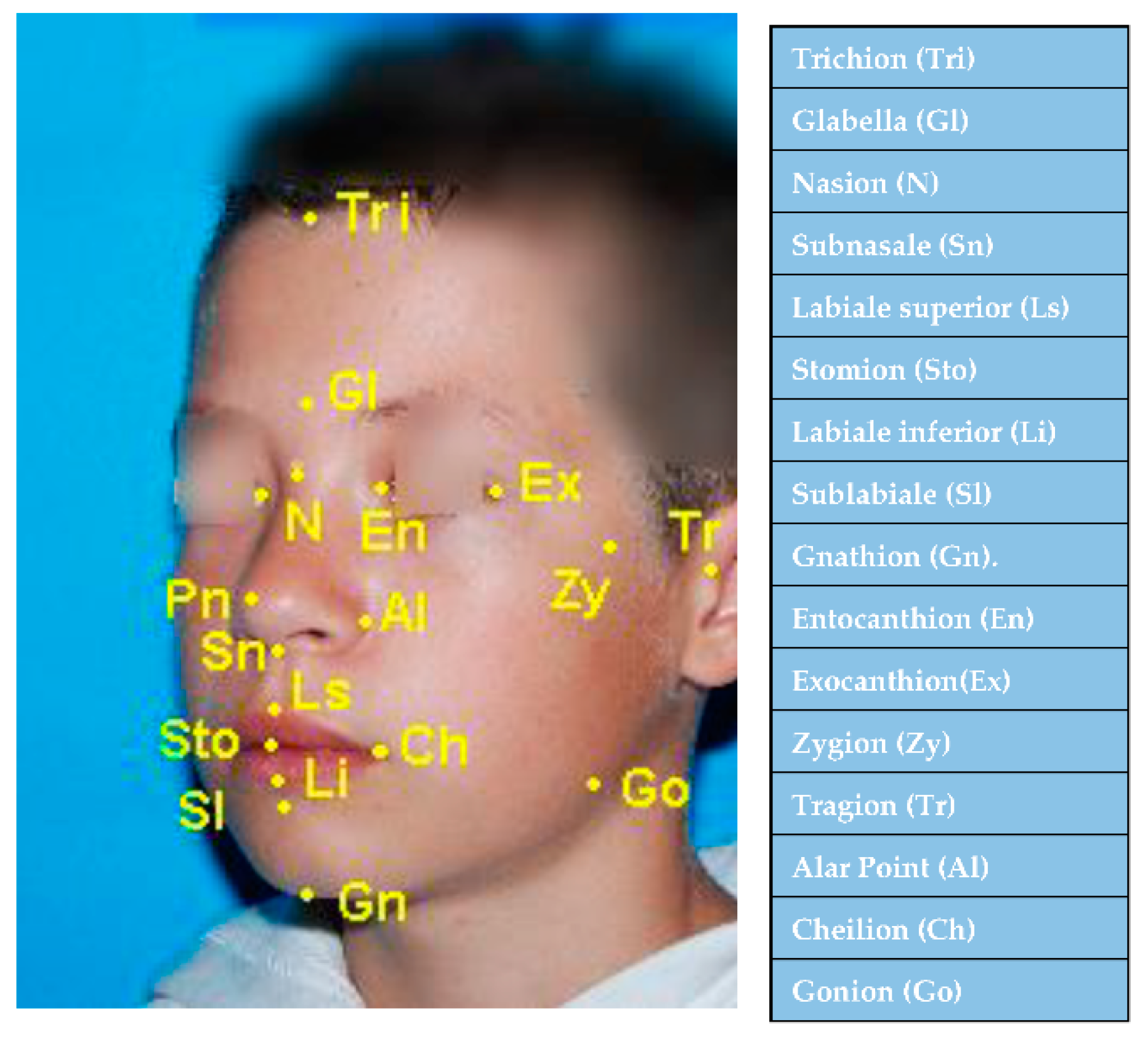
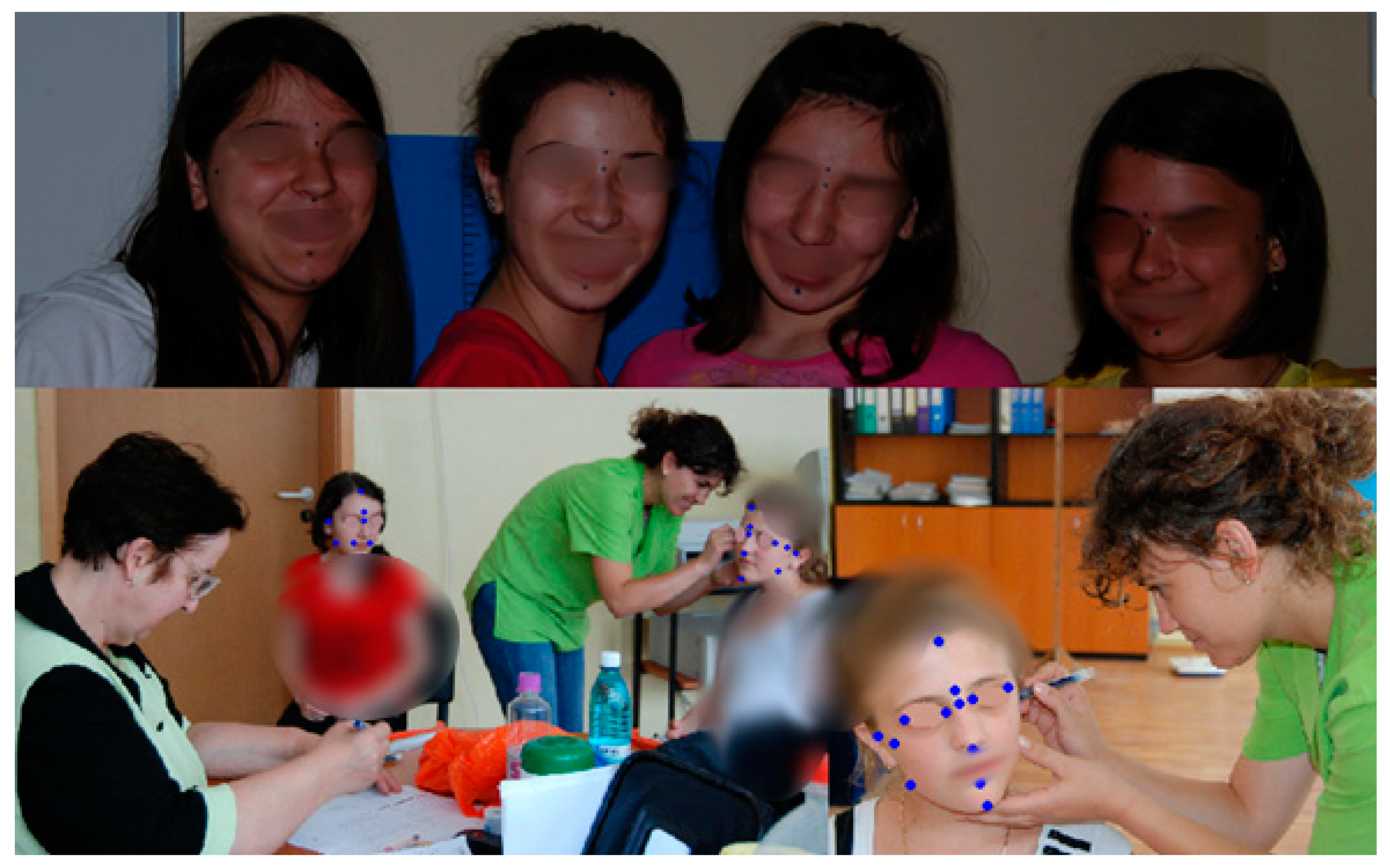

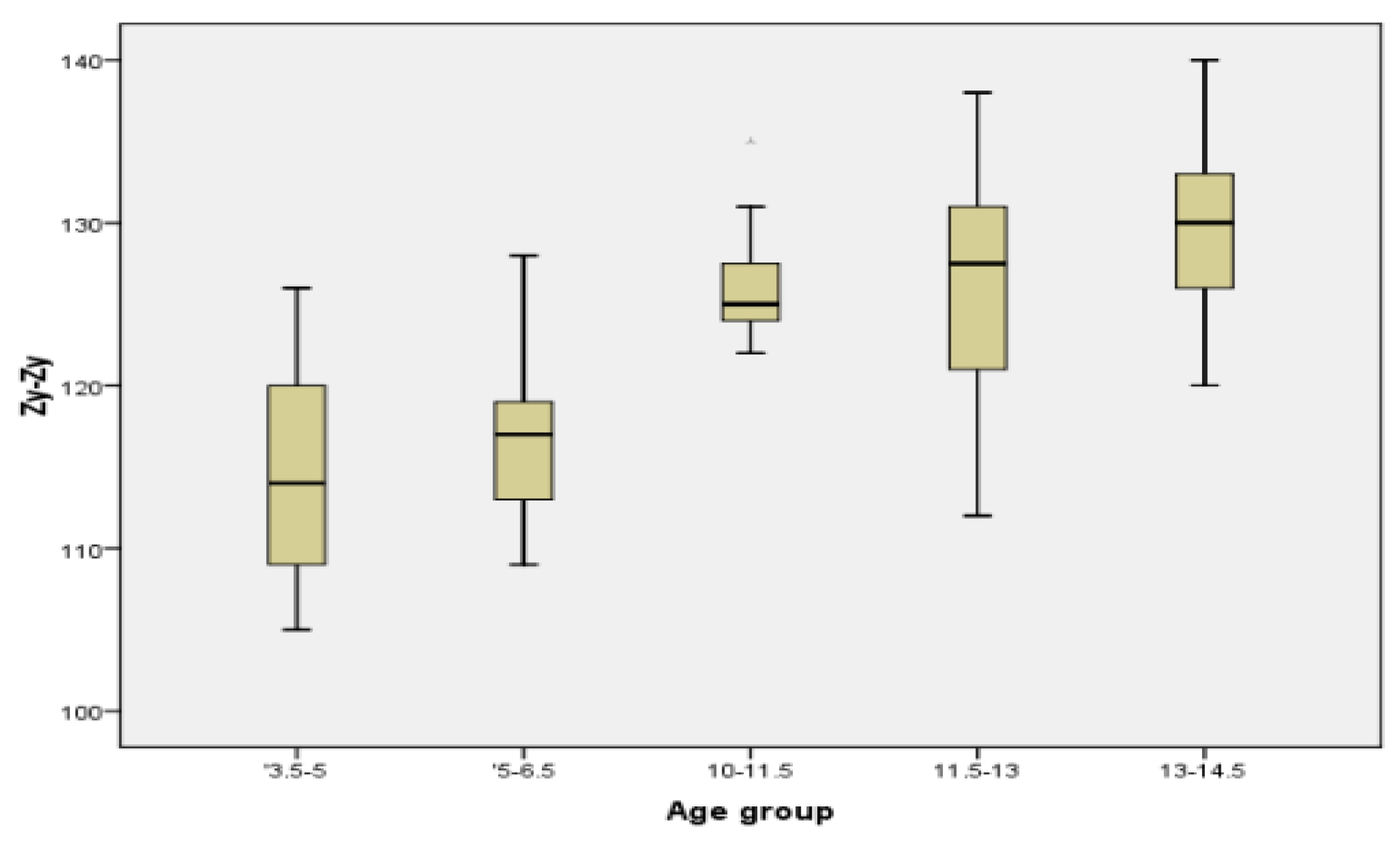


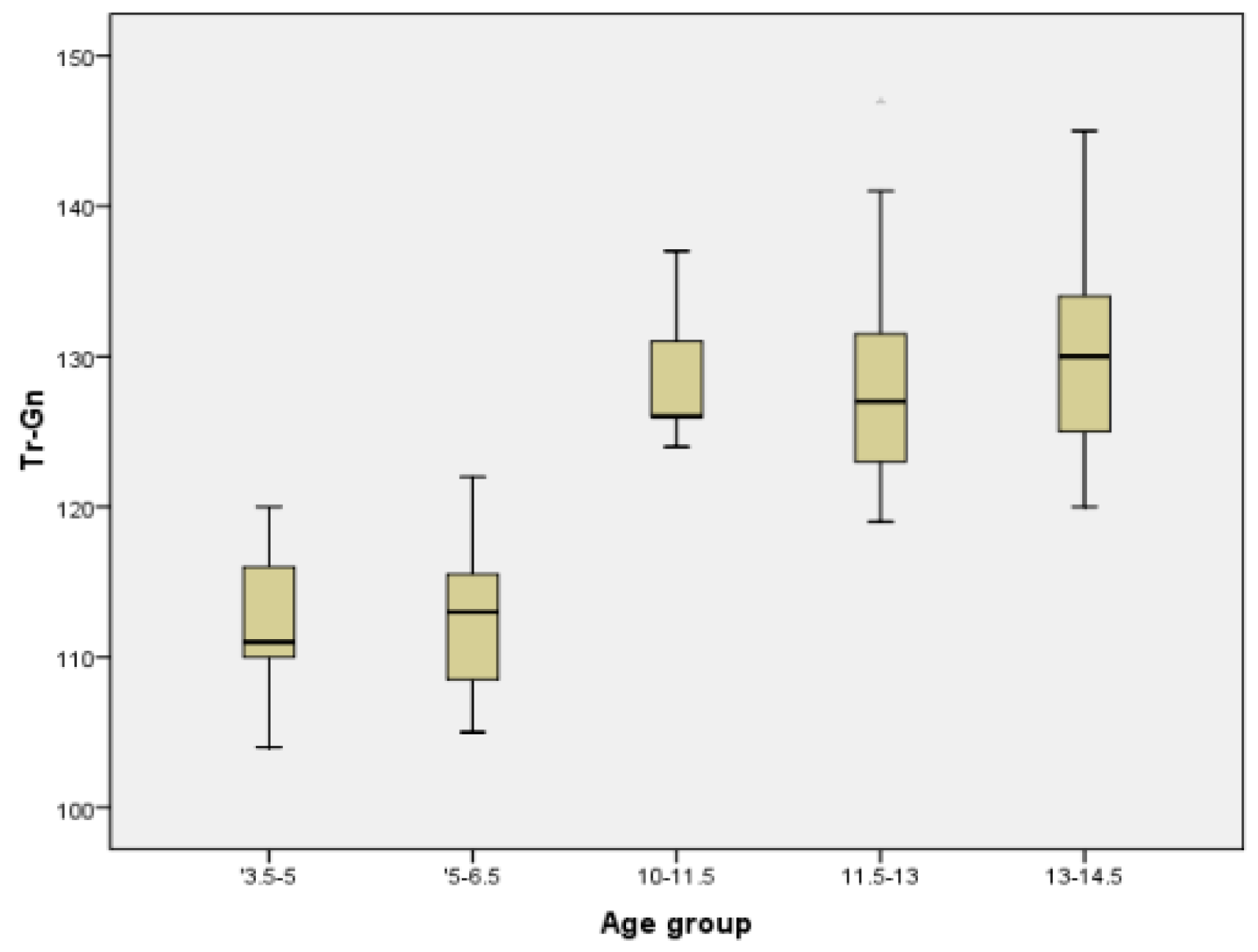
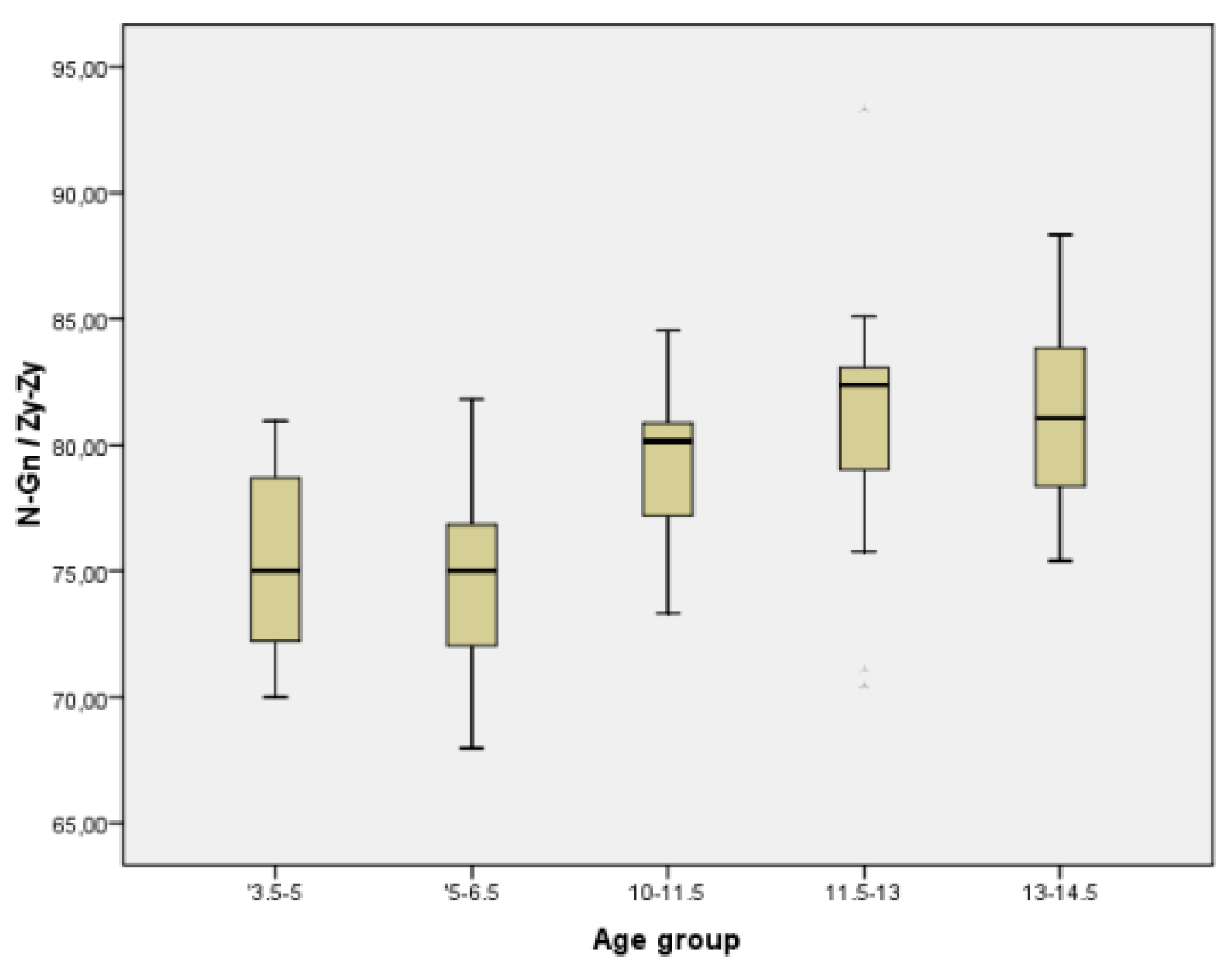
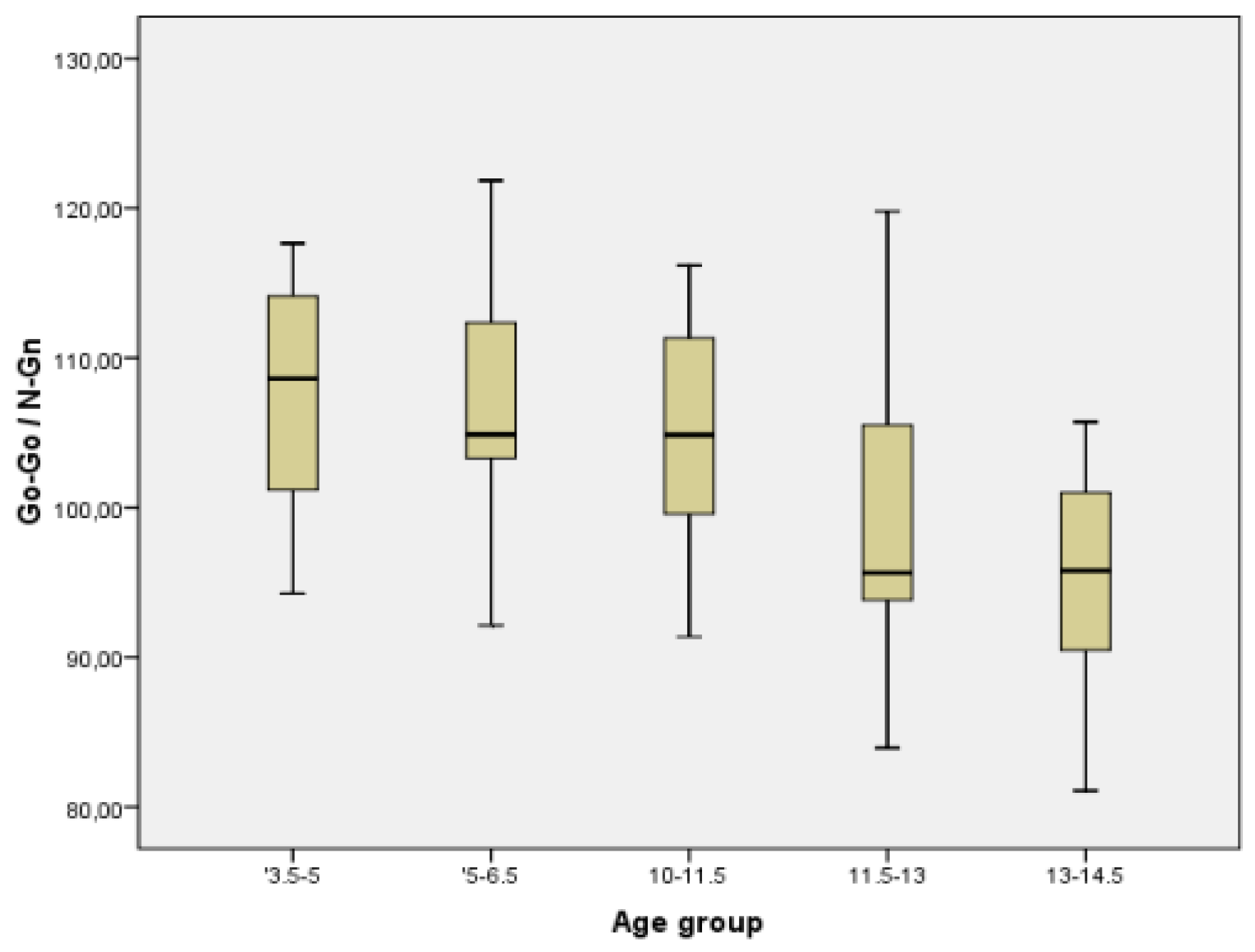
| Age-Group (Years) | Number of Subjects | Percentage (%) |
|---|---|---|
| 3.5–5 | 14 | 16.5% |
| 5–6.5 | 11 | 13% |
| 10–11.5 | 11 | 13% |
| 11.5–13 | 28 | 33% |
| 13–14.5 | 21 | 24.5% |
| Facial Dimensions (mm) | 3.5–5 Years Mean ± SD (Min–Max) | 5–6.5 Years Mean ± SD (Min–Max) | 10–11.5 Years Mean ± SD (Min–Max) | 11.5–13 Years Mean ± SD (Min–Max) | 13–14.5 Years Mean ± SD (Min–Max) |
|---|---|---|---|---|---|
| Zy-Zy | 114.79 ± 6.15 (105–126) | 116.91 ± 6.02 (109–128) | 126.18 ± 3.87 (122–135) | 126.25 ± 6.52 (112–138) | 129.43 ± 5.48 (120–140) |
| Go-Go | 92.64 ± 5.61 (82–100) | 93.45 ± 7.33 (82–106) | 104.45 ± 6.9 (93–115) | 101.18 ± 9.67 (87–123) | 100.1 ± 7.71 (88–113) |
| Ch-Ch | 35.93 ± 3.43 (31–42) | 36.82 ± 2.86 (32–41) | 43.09 ± 3.39 (37–48) | 44.36 ± 3.72 (35–51) | 44.14 ± 3.93 (36–54) |
| Al-Al | 27.43 ± 1.6 (26–32) | 27.27 ± 1.56 (26–31) | 30.36 ± 2.01 (26–33) | 29.64 ± 2.77 (25–37) | 30.29 ± 2.08 (26–33) |
| En-En | - | - | 29.55 ± 2.21 (25–33) | 30.36 ± 2.2 (26–37) | 31.33 ± 2.39 (25–37) |
| N-middle of Pupilla | - | 29.91 ± 0.83 (29–31) | 29.86 ± 2.74 (24–35) | 31.9 ± 1.87 (28–35) | |
| Ex-Ex | 91.21 ± 6.64 (80–102) | 96.18 ± 6.42 (87–106) | 99.25 ± 4.86 (90–108) | 97.36 ± 5.1 (89–109) | 103.5 ± 4.95 (100–107) |
| N-Gn | 86.29 ± 2.37 (83–91) | 87.55 ± 4.32 (82–96) | 100.09 ± 3.48 (95–105) | 102.25 ± 6.22 (91–114) | 105.19 ± 5 (92–111) |
| N-Sn | 34.29 ± 1.73 (31–37) | 36.09 ± 3.81 (31–43) | 45.45 ± 2.25 (42–49) | 43.68 ± 3.54 (38–50) | 44.62 ± 3.83 (36–52) |
| N-Sto | 52.86 ± 2.57 (49–57) | 55.36 ± 3.07 (51–60) | 63.82 ± 3.09 (58–68) | 62.96 ± 4.35 (54–71) | 64.43 ± 3.11 (60–71) |
| Sn-Gn | 51.29 ± 2.16 (49–57) | 52.18 ± 3.09 (46–57) | 57.18 ± 5.13 (52–68) | 58.61 ± 4.43 (50–66) | 60 ± 4.1 (52–66) |
| Sn-Sto | 17.43 ± 1.87 (14–20) | 19.55 ± 4.34 (12–29) | 19.09 ± 3.21 (14–25) | 18.68 ± 2.83 (12–23) | 18.9 ± 1.41 (16–21) |
| Sto-Gn | 35.71 ± 3.02 (30–40) | 34.45 ± 1.21 (33–37) | 36.82 ± 3.79 (31–43) | 39.96 ± 3.14 (32–45) | 40.86 ± 3.35 (33–48) |
| Sto-Ls | 6.25 ± 1.55 (3–9) | 6.41 ± 1.71 (4–10) | 7.55 ± 1.04 (6–9) | 6.89 ± 1.49 (4.5–11) | 6.67 ± 1.56 (4–10) |
| Sto-Li | 7.89 ± 1.39 (5–10) | 6.45 ± 1.13 (5–9) | 8.91 ± 1.76 (6–11) | 9.07 ± 1.22 (6.5–12) | 8.9 ± 1.79 (7–13) |
| Sto-Sl | 14.79 ± 1.76 (12–18) | 13.36 ± 1.91 (11–16) | 16.18 ± 2.44 (11–18) | 17.02 ± 1.99 (13–22) | 16.29 ± 2.28 (13–21) |
| Sl-Gn | 20.93 ± 3.41 (13–25) | 21.09 ± 2.77 (17–26) | 20.64 ± 2.46 (18–25) | 23.55 ± 4.07 (16–35) | 24.57 ± 3.16 (17–30) |
| G-Sn | 42.79 ± 2.46 (40–47) | 44.27 ± 3.93 (38–50) | 59.09 ± 4.53 (52–69) | 53.75 ± 4.97 (47–69) | 55 ± 3.41 (48–61) |
| Tri-Sn | 95.71 ± 4.1 (91–103) | 97 ± 6.07 (89–107) | 105.45 ± 4.61 (101–114) | 107.86 ± 8.98 (90–122) | 113 ± 8.83 (97–128) |
| Tr-Gn | 112.14 ± 4.85 (104–120) | 112.55 ± 5.35 (105–122) | 128.45 ± 4.2 (124–137) | 128.36 ± 6.93 (119–147) | 130 ± 6.38 (120–145) |
| Tr-Sn | 103.57 ± 2.24 (99–107) | 103.45 ± 6.02 (94–111) | 115.36 ± 3.32 (111–122) | 115.57 ± 5.33 (108–131) | 118.14 ± 6.24 (105–127) |
| Tr-N | 100.86 ± 2.68 (94–104) | 101 ± 3.44 (95–105) | 110.55 ± 3.53 (106–119) | 112.54 ± 5.1 (102–125) | 114.38 ± 4.75 (107–121) |
| Tr-Tr | 121.21 ± 4.37 (112–126) | 122.36 ± 5.1 (115–131) | 130.64 ± 4.84 (121–137) | 132.25 ± 6 (120–144) | 134.38 ± 6.36 (122–145) |
| Facial Anthropometric Indices | 3.5–5 Years Mean ± SD (Min–Max) | 5–6.5 Years Mean ± SD (Min–Max) | 10–11.5 Years Mean ± SD (Min–Max) | 11.5–13 Years Mean ± SD (Min–Max) | 13–14.5 years Mean ± SD (Min–Max) |
|---|---|---|---|---|---|
| N-Gn/Zy-Zy | 75.34 ± 3.87 (70–80.95) | 75 ± 4.25 (67.97–81.82) | 79.38 ± 3.49 (73.33–84.55) | 81.07 ± 4.46 (70.45–93.33) | 81.33 ± 3.55 (75.41–88.33) |
| Go-Go/Zy-Zy | 80.84 ± 5.32 (69.84–91.67) | 79.88 ± 3.52 (75.23–85.45) | 82.77 ± 4.59 (75–88.8) | 80.03 ± 4.71 (72–89.15) | 77.26 ± 3.43 (70.31–82.31) |
| Go-Go/N-Gn | 107.48 ± 7.72 (94.25–117.65) | 106.83 ± 7.81 (92.13–121.84) | 104.51 ± 8.27 (91.35–116.16) | 99.07 ± 8.84 (83.93–119.79) | 95.24 ± 6.95 (81.08–105.71) |
| Sto-Gn/Go-Go | 38.7 ± 4.21 (31.96–46.34) | 37.1 ± 3.54 (31.13–43.9) | 35.36 ± 4.19 (30.1–45.26) | 39.83 ± 4.66 (28.57–47.13) | 41.01 ± 4.34 (34.02–51.14) |
| Ch-Ch/Go-Go | 38.77 ± 2.66 (33.7–42.42) | 39.47 ± 2.61 (36.79–44.09) | 41.33 ± 3.23 (35.92–46.94) | 44.04 ± 3.87 (36.52–52.22) | 44.19 ± 3.48 (38.53–53.47) |
| Sn-Sto/Ch-Ch | 48.77 ± 5.79 (39.02–60.61) | 52.78 ± 9.1 (37.5–70.73) | 44.88 ± 10.2 (29.17–67.57) | 42.23 ± 6.15 (26.67–51.11) | 43.11 ± 4.7 (33.33–55.56) |
| Sto-Sl/Ch-Ch | 41.4 ± 5.71 (32.43–54.84) | 36.27 ± 4.05 (29.73–41.03) | 37.74 ± 6.4 (25–46.15) | 37.19 ± 8.95 (0–52.38) | 37.17 ± 6.45 (27.66–58.33) |
| N-Sto/Zy-Zy | 46.13 ± 2.58 (42.86–51.85) | 47.44 ± 3.2 (42.97–52.29) | 50.62 ± 2.87 (45.19–53.66) | 49.93 ± 3.3 (42.64–55.47) | 49.83 ± 2.51 (45.26–55.47) |
| Sn-Gn/N-Gn | 59.44 ± 1.87 (56.98–62.64) | 59.63 ± 2.72 (56.1–63.22) | 57.08 ± 3.96 (53–66.02) | 57.34 ± 3.18 (52.78–65.66) | 57.04 ± 2.79 (51.46–61.9) |
| Sto-Gn/N-Gn | 41.38 ± 3.22 (34.88–46.51) | 39.44 ± 2.22 (35.42–42.53) | 36.77 ± 3.33 (31–41.35) | 39.14 ± 2.95 (32.32–44.9) | 38.86 ± 2.91 (33.02–44.44) |
| Sto-Gn/N-Sto | 67.68 ± 6.15 (56.6–77.55) | 62.41 ± 4.11 (56.67–68.63) | 57.73 ± 5.54 (48.44–65.15) | 63.61 ± 4.91 (52.24–74.58) | 63.58 ± 6.37 (51.47–78.69) |
| Sto-Gn/Sn-Gn | 69.68 ± 5.79 (59.62–81.63) | 66.24 ± 4.52 (59.65–72) | 64.49 ± 5.12 (58.49–73.08) | 68.33 ± 4.78 (59.26–78.57) | 68.23 ± 5.56 (61.11–84.91) |
| Ls-Sto/Sto-Li | 79.99 ± 19.42 (42.86–120) | 100.88 ± 27.62 (66.67–150) | 86.41 ± 12.94 (70–114.29) | 76.19 ± 14.09 (55.56–122.22) | 75.52 ± 14.32 (50–100) |
| Sto-Sl/Sn-Sto | 85.5 ± 12 (70–106.25) | 70.76 ± 15.55 (50–100) | 86.67 ± 19.08 (61.11–121.43) | 89.87 ± 22.92 (0–133.33) | 86.68 ± 14.51 (66.67–125) |
| Sn-Sto/Sto-Gn | 49.08 ± 6.39 (38.89–64.52) | 56.85 ± 13.1 (34.29–85.29) | 52.19 ± 9.23 (36.84–69.44) | 46.93 ± 7.5 (27.27–60) | 46.55 ± 4.79 (33.33–54.55) |
| Sl-Gn/Sn-Gn | 40.76 ± 6.24 (26.53–48.98) | 40.58 ± 6.04 (30.91–50) | 36.13 ± 3.31 (32.14–41.67) | 40.28 ± 7.07 (29.63–61.4) | 40.93 ± 4.4 (31.48–50.85) |
| Age Group (Years) | Girls | Boys | ||
|---|---|---|---|---|
| Height (cm) (Mean ± SD) | Weight (kg) (Mean ± SD) | Height (cm) (Mean ± SD) | Weight (kg) (Mean ± SD) | |
| 3.5–4.4 | 107 ± 4.97 | 18.21 ± 2.18 | 106.67 ± 4.93 | 17.67 ± 2.52 |
| 4.5–5.4 | 110 ± 5.77 | 20.42 ± 3.77 | 112.86 ± 6.41 | 21.54 ± 4.07 |
| 5.5–6.4 | 118.75 ± 3.69 | 22.64 ± 2.55 | 126 ± 7.79 | 24.71 ± 4.93 |
| 6.5–7.4 | 122.67 ± 6.43 | 22.75 ± 1.71 | 124.75 ± 6.58 | 25.41 ± 5.34 |
| 7.5–8.4 | 132.67 ± 4.95 | 33.21 ± 8.52 | 132.57 ± 7.39 | 33.57 ± 9.84 |
| 8.5–9.4 | 133.18 ± 5.91 | 33.58 ± 7.17 | 135.39 ± 8.77 | 31.29 ± 5.52 |
| 9.5–10.4 | 139.27 ± 5.7 | 33.24 ± 5.94 | 133.29 ± 12.11 | 33.65 ± 6.52 |
| 10.5–11.4 | 149.83 ± 8.35 | 43.91 ± 12.92 | 147.33 ± 6.41 | 39.92 ± 7.86 |
| 11.5–12.4 | 154.56 ± 8.25 | 45.01 ± 9.74 | 152.74 ± 7.09 | 46.85 ± 10.29 |
| 12.5–13.4 | 157.47 ± 6.71 | 45.32 ± 7.28 | 161.33 ± 9.45 | 53.17 ± 12.49 |
| 13.5–14.4 | 161.08 ± 5.3 | 49.78 ± 8.06 | 164.25 ± 5.28 | 58.6 ± 9.72 |
| 14.5–15.4 | 159.5 ± 2.12 | 53.75 ± 9.55 | 165.83 ± 11.58 | 58.43 ± 21.93 |
| Facial Parameters | Height | Weight | ||
|---|---|---|---|---|
| Correlation Coefficient | p-Value | Correlation Coefficient | p-Value | |
| Zy-Zy | 0.827 | <0.001 | 0.805 | <0.001 |
| Go-Go | 0.526 | <0.001 | 0.626 | <0.001 |
| N-Gn | 0.938 | <0.001 | 0.895 | <0.001 |
| N-Sn | 0.847 | <0.001 | 0.751 | <0.001 |
| Sn-Sto | 0.124 | 0.354 | 0.099 | 0.444 |
| Sto-Gn | 0.783 | <0.001 | 0.785 | <0.001 |
| Tr-Gn | 0.893 | <0.001 | 0.925 | <0.001 |
| Tr-Sn | 0.861 | <0.001 | 0.848 | <0.001 |
| Tr-Tr | 0.814 | <0.001 | 0.720 | <0.001 |
Publisher’s Note: MDPI stays neutral with regard to jurisdictional claims in published maps and institutional affiliations. |
© 2021 by the authors. Licensee MDPI, Basel, Switzerland. This article is an open access article distributed under the terms and conditions of the Creative Commons Attribution (CC BY) license (https://creativecommons.org/licenses/by/4.0/).
Share and Cite
Ogodescu, E.; Popa, M.; Luca, M.; Igna, A.; Miron, M.; Martha, K.; Tudor, A.; Todea, C. Updating Standards of Facial Growth in Romanian Children and Adolescents Using the Anthropometric Method—A Pilot Study. Int. J. Environ. Res. Public Health 2021, 18, 5288. https://doi.org/10.3390/ijerph18105288
Ogodescu E, Popa M, Luca M, Igna A, Miron M, Martha K, Tudor A, Todea C. Updating Standards of Facial Growth in Romanian Children and Adolescents Using the Anthropometric Method—A Pilot Study. International Journal of Environmental Research and Public Health. 2021; 18(10):5288. https://doi.org/10.3390/ijerph18105288
Chicago/Turabian StyleOgodescu, Emilia, Malina Popa, Magda Luca, Andreea Igna, Mariana Miron, Krisztina Martha, Anca Tudor, and Carmen Todea. 2021. "Updating Standards of Facial Growth in Romanian Children and Adolescents Using the Anthropometric Method—A Pilot Study" International Journal of Environmental Research and Public Health 18, no. 10: 5288. https://doi.org/10.3390/ijerph18105288
APA StyleOgodescu, E., Popa, M., Luca, M., Igna, A., Miron, M., Martha, K., Tudor, A., & Todea, C. (2021). Updating Standards of Facial Growth in Romanian Children and Adolescents Using the Anthropometric Method—A Pilot Study. International Journal of Environmental Research and Public Health, 18(10), 5288. https://doi.org/10.3390/ijerph18105288







